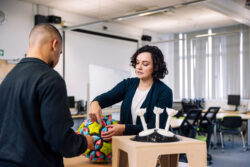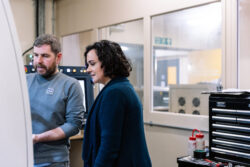Briony Thomas - Creative Science in Schools - IAA Case Study

Dr Briony Thomas used her joint appointment at the School of Mechanical Engineering and School of Design to expand her Creative Science in Schools project, using Impact Acceleration Account (IAA) funding to broaden teaching methods across the school science curriculum.
Securing funding to expand existing activities
Briony’s work began as a Public Engagement Fellowship project at the University of Leeds, which grew rapidly. ‘Initially, the Medical Research Council provided some funding for our first year of activities within local schools,’ she says. ‘However, we wanted to share our work more widely. Though I knew of many large grants available, our challenge was finding smaller pots of money to extend the project – until we discovered the IAA funding.’
‘Creative Education, by its nature, is an Economic and Social Research Council (ESRC) area, so the IAA funding felt like something I could go for,’ Briony adds. ‘I successfully applied through the Public Engagement strand, proposing to focus our IAA-funded work on a second year with the schools to widen our networks.’
Developing partnerships to empower young people
Briony and her colleagues had been running their Creative Science in Schools project with an academy trust in Batley, West Yorkshire, for a couple of years. After she secured the IAA funding, Briony spoke to the school trust about the potential of extending their partnership.
‘At the time, it was clear young people didn’t truly understand what was happening during the Covid-19 pandemic, and there was a lot of misinformation,’ Briony explains. ‘This was particularly targeted at certain demographics, such as young people who were told receiving a vaccine was at odds with their religious beliefs. We wanted to understand how we could support teachers to discuss these issues in school, and co-created a series of STEAM education activities that brought together creative arts and science teachers to deliver a cross-curricular learning programme. The children gave us questions that they wanted to ask scientists, which we used to shape the educational activities. This empowered the children with the knowledge to answer their own queries and challenge the information they received.’
Providing new platforms to share information
‘We feel there’s a gap in the national curriculum where some valuable topics, like the science of disease prevention and control, aren’t covered until children specialise in key subjects,’ Briony says. ‘We wanted to expand general science knowledge, so we focussed on the 7-13 age group, carrying out creative activities to explore key areas. This encouraged informal discussions amongst the children about their science learning, which the teachers observed and supported in the classroom.’
Though Briony applied for the IAA funding and steered the project, she’s keen to stress the work is a collaborative effort. ‘The project couldn’t be delivered by any one discipline, so it’s crucial to bring together different skills and experiences,’ she says. ‘We’ve worked with five faculties in the university (biology, medicine, arts, engineering and education), research students and designers. And we couldn’t deliver the project without the school leadership teams. Their partnership is critical to help us design activity programmes and identify gaps and challenges.’

Exploring opportunities to engage wider audiences
‘Our IAA funding runs until March 2023, so we can broaden the work we deliver,’ explains Briony. ‘For example, we were invited to deliver creative workshop activities at the Otley Science Fair in November 2022. When we applied for the IAA funds, we hadn’t featured the science fair in the scope of our work. Yet its late inclusion made sense as our work evolved, as it’s allowed us to connect with families in a different way at a new location.’
Next for Briony and her team is to share their work with an even larger audience. ‘At its heart, our project is an equal partnership between us and the schools we support,’ she says. ‘Shortly, we’ll be hosting an exhibition stand at a science education conference alongside pupils who’ll be talking about their science learning. That will open the project nationally to science educators, who can share their experiences, engage with the arts and deliver material that’s outside the formal curriculum.’
‘I was also invited to deliver a talk for the World Health Organisation on using arts to communicate science during the pandemic,’ Briony concludes. ‘It was a real honour, and chance for me to share the value of the work we’re doing on a global platform.’
